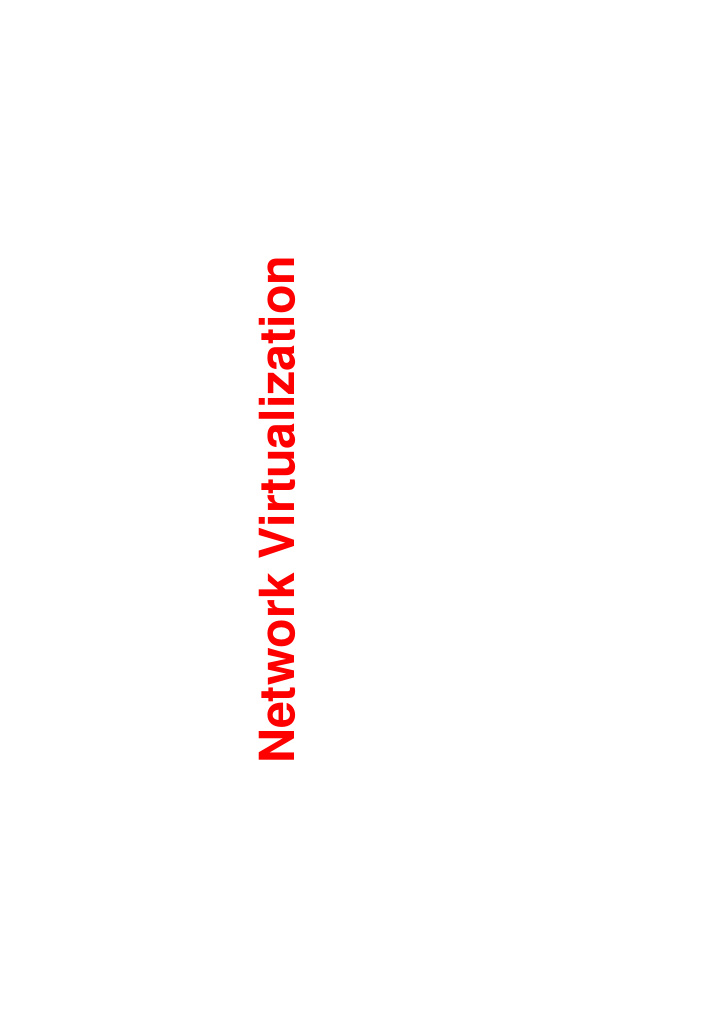



Network Virtualization
What is Network Virtualization? • Abstraction of the physical network – Support for multiple logical networks running on a common shared physical substrate – A container of network services • Aspects of the network that can be virtualized – Nodes: Virtual machines – Links: Tunnels (e.g., Ethernet GRE) – Storage
Network Virtualization Source: Bruce Davie 3
Motivation for Network Virtualization • “Ossification” of the Internet architecture – Lots of work on overlay networks in the 2000s – One-size-fits all architectures are difficult – Why not allow for easier evolution? • Instead, why not create a substrate where “1,000 flowers can bloom”? 4
The Promise of Network Virtualization • Rapid innovation: services delivered at software speeds (vswitch and controller) • New forms of network control • Vendor choice • Simplified programming and operations http://networkheresy.com/2013/04/29/netvirt-delivering/ 5
Related: Virtual Private Networks • Virtual network that connects distributed sites – Basically, secure tunneling • Not designed to let multiple custom architectures run on the infrastructure 6
Design Goals • Flexibility: topologies, routing and forwarding architecture; independent configuration • Manageability: separate policy and mechanism • Scalability: maximize number of co-existing virtual networks • Security and Isolation: isolate both the logical networks and the resources • Programmability: programmable routers, etc. • Heterogeneity: support for different technologies 7
Virtual Nodes/Machines • Xen Virtual Machine Monitor • User-Mode Linux (with network namespaces, now part of Linux kernel) • KVM (Linux kernel virtualization) • Other virtual machine solutions – VMWare – Virtual Box 8
Example VM Environment: Xen • Xen hosts multiple guest OSes. • Domain0 runs control software in the XenoLinux environment. Barham, Paul, et al. "Xen and the art of virtualization." ACM SIGOPS Operating Systems Review 37.5 (2003): 9 164-177.
Example Virtual Links: EGRE • Ethernet GRE (EGRE) Tunneling: Ethernet frames from virtual hosts are encapsulated in IP packets • Other approaches: VXLAN Bhatia, Sapan, et al. "Trellis: A platform for building flexible, fast virtual networks on commodity hardware." Proceedings of the 2008 ACM CoNEXT Conference . ACM, 2008. 10
Switches: Open vSwitch • Problem: Networking virtual machines together over a Layer 2 topology – (e.g., VINI used “shortbridge”, an extension of Linux bridging) • Open vSwitch performs similar glue functions – Also can be configured remotely with OpenFlow, JSON http://openvswitch.org/ 11
Summary • Motivation: Flexible, agile deployment – Rapid innovation, vendor independence, scale • Technologies: Virtual nodes, links, switches • SDN vs. Virtual Networks – SDN separates data plane and control plane – Virtual networks separate logical and physical networks – SDN can be a useful tool for implementing virtual networks 12
Applications of Virtual Networking • Experimentation on production networks – Can run (virtual) experimental infrastructure in parallel with production • Rapid deployment and development – Can deploy services independently from underlying vendor hardware • Dynamic scaling of resources – Can allocate from “pool” of resources
Experimentation on Production Networks • How to test and deploy a “paper design”? • Goal: Realism • Ideally: Deploy in parallel in production 14
FlowVisor: Virtualizing Network Control • User (“Doug”) can let different flows be controlled by different groups of researchers • Virtualization of control based on “flow space” (IP address, port, etc.) Sherwood, Rob, et al. "Can the production network be the testbed.” Proceedings of the 9th USENIX conference on Operating 15 systems d i d i l t ti USENIX A i ti 2010
Rapid Deployment of Services: Nicira Network Virtualization Platform • Abstraction layer between hosts & underlying network • Open vSwitch in host hypervisors: abstraction layer • Managed by distributed controller http://nicira.com/en/network-virtualization-platform 16
Nicira NVP: Applications • Dynamic workload placement – Multi-tenant data centers – Creation of isolated virtual networks for each tenant • Dynamic security – Central management of security policies – Enforcement per virtual network – Independence from VLAN limits 17
Dynamic Scaling of Resources: Amazon Virtual Private Cloud • Connect logically isolated VM instances to existing network • Connection to existing infrastructure via VPN http://aws.typepad.com/aws/2009/08/introducing-amazon-virtual-private- cloud-vpc.html 18
Amazon Virtual Private Cloud • Allows customers to define their own network, address space, etc. • Extend existing enterprise data center – VPN between Amazon VPC and data center • Applications/Benefits – Dynamic scaling – Disaster recovery – Manageability 19
Many Other Examples of Virtualization • Wide-Area Virtual Networks – Experimental infrastructure: VINI, GENI – Value-added services: CABO – Multiple control infrastructures: Tempest • Virtual “Network in a Box” – Open vSwitch, Citrix, Vyatta, OpenSolaris, Microsoft Virtual Server • Network functions virtualization 20
Summary: Applications of Virtual Networking • Experimental deployments • Isolation on shared infrastructure • Reuse of resource pool • Dynamic scaling • Easier management of “logical” resources 21
Recommend
More recommend